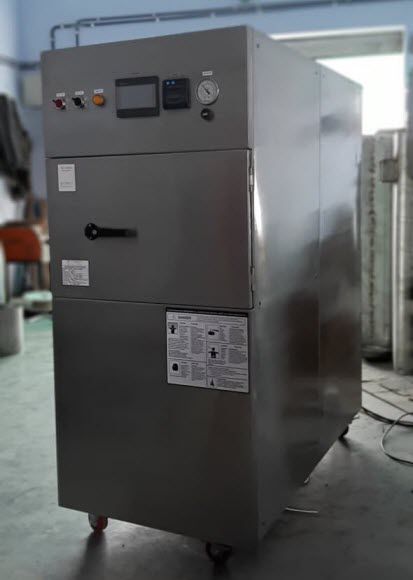In disaster-prone Japan, the role of ETO Sterilizers in preparedness is paramount. These sterilizers hold immense significance in maintaining essential services during emergencies. Operating on the principle of ethylene oxide gas, they effectively sterilize medical equipment, ensuring their safe reuse and uninterrupted availability.
Japan’s susceptibility to natural calamities like earthquakes, typhoons and tsunamis necessitates robust disaster preparedness strategies. ETO Sterilizers contribute significantly to this effort by mitigating the risks of contamination and infection. By thoroughly sterilizing critical medical supplies, these machines enable healthcare facilities to function optimally even amidst chaos.
During disaster response operations, access to clean and safe medical tools becomes crucial. ETO Sterilizers play a pivotal role in reducing the spread of diseases and secondary health crises, as they eliminate harmful pathogens that might be present on equipment used in rescue and relief operations.
Ensuring Continuity of Medical Supplies
During disasters, the demand for medical supplies surges, putting immense pressure on healthcare facilities. ETO Sterilizers play a crucial role in maintaining a steady supply of medical equipment and instruments during such critical times.
By employing advanced sterilization techniques, ETO Sterilizers effectively eradicate harmful pathogens from medical tools, making them safe for reuse. This process ensures that healthcare facilities can efficiently manage their resources and avoid shortages, even in the face of overwhelming demand.
The ability to reuse critical items through ETO Sterilization not only reduces the strain on the supply chain but also minimizes waste, making it an environmentally sustainable solution. This sustainable approach to disaster management helps in conserving resources and protecting the environment.
Healthcare providers can rely on ETO Sterilizers to uphold high standards of hygiene and safety, mitigating the risk of infections during emergencies. The availability of sanitized medical supplies allows medical professionals to deliver optimal care to patients, enhancing the overall disaster response efforts.

Mitigating Disease Outbreaks
In the aftermath of natural disasters, disease outbreaks pose a significant threat to affected communities. ETO Sterilizers play a vital role in mitigating such outbreaks by effectively sterilizing medical tools and equipment.
During disasters, healthcare facilities often witness an influx of patients, increasing the risk of infections. ETO Sterilizers utilize ethylene oxide gas to eliminate harmful pathogens from medical instruments, reducing the chances of cross-contamination and the spread of infectious diseases.
By ensuring that medical tools are thoroughly sanitized and safe for use, ETO Sterilizers help prevent secondary health crises that can further burden relief efforts. Contaminated instruments could exacerbate existing health conditions or lead to new infections, hindering recovery and relief operations.
The quick and efficient sterilization provided by ETO Sterilizers is crucial in containing outbreaks and safeguarding the well-being of both patients and healthcare providers. Additionally, their ability to sterilize a wide range of medical equipment makes them indispensable in disaster response scenarios.
Mitigating disease outbreaks is not only a matter of immediate concern but also a long-term strategy to promote public health in the aftermath of disasters. ETO Sterilizers, by reducing the risk of infections and secondary complications, significantly contribute to comprehensive disaster management efforts.
ETO Sterilizers in Evacuation Centers
In times of disaster, evacuation centers serve as safe havens for displaced individuals. The incorporation of ETO Sterilizers in these centers plays a crucial role in enhancing safety and hygiene conditions, thereby reducing health hazards for those seeking refuge.
Disasters often lead to overcrowded evacuation centers, making them potential breeding grounds for infections. ETO Sterilizers offer a reliable solution to maintain a clean and sanitized environment in these facilities. By using ethylene oxide gas, these sterilizers can effectively eliminate harmful pathogens from surfaces, medical equipment, and other items, minimizing the risk of disease transmission.
The availability of sanitized spaces in evacuation centers is essential for safeguarding the health of vulnerable populations, including the elderly, children, and individuals with pre-existing medical conditions. ETO Sterilizers help prevent the spread of infections, making the centers a safer place for everyone.
Moreover, ETO Sterilizers support disaster response teams in managing health emergencies within these centers. By ensuring that medical tools are thoroughly sterilized, healthcare providers can deliver effective care to evacuees without compromising their well-being.
Incorporating ETO Sterilizers in evacuation center planning underscores the commitment to provide a conducive and hygienic environment for displaced individuals. By reducing health risks, these sterilizers contribute to better overall conditions, fostering a sense of security and comfort during challenging times.
Regulatory Considerations
The use of ETO Sterilizers in disaster preparedness in Japan is subject to a well-defined regulatory framework that prioritizes safety and compliance. Understanding the regulatory landscape is crucial to ensure the proper implementation of these sterilizers during times of crisis.
In Japan, ETO Sterilizers are regulated by government agencies responsible for healthcare, disaster management, and environmental safety. These agencies set forth guidelines and standards for the safe and effective use of sterilization equipment in emergency situations.
Compliance requirements encompass various aspects, including proper training for personnel handling ETO Sterilizers, routine maintenance and calibration of the machines, and adherence to specific sterilization protocols. Regular inspections and audits are conducted to ensure that facilities using ETO Sterilizers meet all regulatory obligations.
Safety standards for ETO Sterilizers focus on preventing accidents, mitigating potential risks, and safeguarding both users and the environment. This includes measures to control emissions of ethylene oxide gas, which can be hazardous in large quantities, as well as guidelines for handling and storing sterilizing agents safely.
In addition to government regulations, healthcare institutions and disaster response organizations often follow industry best practices and international standards for ETO Sterilization. These guidelines further enhance the quality and effectiveness of disaster preparedness efforts.
Staying updated with evolving regulations is essential for organizations involved in disaster response to ensure continuous compliance. Proper training and awareness programs are conducted to educate staff about the latest regulatory changes and safety protocols, promoting a culture of safety and responsibility.






